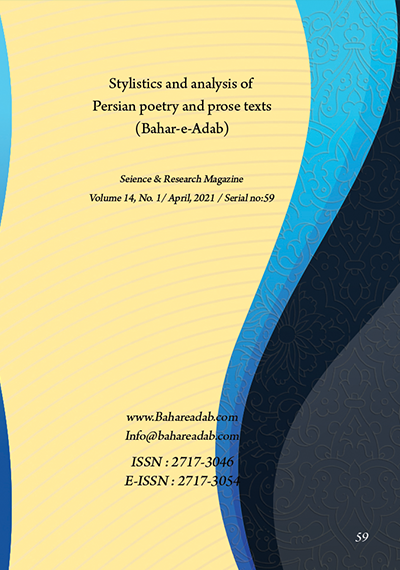- Count View : 557
- آدرس کوتاه شده مقاله: https://bahareadab.com/article_id/1060
- کد doi مقاله: Doi: 10.22034/bahareadab.2021 .14 .4563
Journal of the stylistic of Persian poem and prose
volume Number 14،
number In Volume 1،
،
issue Number 59
Investigating the paradoxical use of Kaleem Kashani's poems From four perspectives of content, aesthetics, mysticism and two-way communication
Zohreh Rahemi , Asghar Rezapourian (Author in Charge), Mohammad Hakim Azar
Abstract
BACKGROUND AND OBJECTIVES: Paradox is one of the factors of unfamiliarity and prominence of words in poetry. This literary technique has been used more or less in Persian literature since the sixth century AH and in the tenth century AH, it has become a prominent feature of the Indian style. This face of imaginary faces that appears in the poems of Kaleeme Kaashaani with considerable frequency, leads the reader’s mind to discover the relationship between two seemingly contradictory words, to be able to take special pleasure in receiving the new semantic load of words and to understand how the hidden truth behind this contradictory appearance causes incompatibility between incompatible parties. The present study has examined the paradox in the collection of poems of Kaleeme Kaashaani and has analyzed various effects according to four perspectives:
‘content, aesthetics, mysticism and the distance and relationship between the paradoxical parties “
METHODOLOGY: This research has been done by descriptive-analytical method.
FINDINGS: One of the most important reasons for the existence of paradoxical images in the poems of the mentioned poet is the expression of high mystical meanings and truths, especially cases related to poverty, prosperity and unity of existence, which often have abstract themes and contents, and ordinary language cannot express them. In general, recognizing paradoxes and interpreting them, makes us more familiar with Kaleem’s poetic thought and language and of course it helps in understanding the style, concept and thematic and contentic features of his poetry collection.
CONCLUSION: The result of the research show that from the content point of view, more than eighty percent of the paradoxes in the poems of Kaleem are interpretive ones ; from an aesthetic point of view the combination of paradoxes with expressive techniques is more frequent than novel ; in terms of distance between the two sides of the contradiction , most of them are documentary ; at the same time , Kaleem has used paradoxes to express mystical issues . In general by using this rhetorical technique , the language of Kaleem has been highlighted and achieved a stylistic identification .
Keyword
Kalim’s poems
, facets of paradox
, semantics
, aesthetics
, mutual distance
, andgnostic points of view.
- Azar Bigdeli, Lotfali Beg. (1999). Atashkade-ye Azar biography, Tehran: Amirkabir, p570.
- Chenari, Amir (1998). Contradictions in Persian Poetry, Tehran: Farzan-e Rooz, p 68.
- Fesharaki, Mohammad. (2016). Critical Badi’e, Tehran: Samt, p 96.
- Goli, Ahmad. Bafker, Sardar. (2018). "Content Paradox in Persian Poetry", Bustan Adab, 10 (2), pp. 129-152.
- Esmaili, Murad. Hassanpour Alashti, Hussein. (2016). "Investigation of Increasing Reasons for the Frequency of Paradox in Indian Style" Quarterly Journal of Subcontinental Studies, Sistan and Baluchestan University, 8 (27), pp. 7-24.
- Kaleem, Mirza Aboutaleb. (2012). Divan Kaleem Kashani, edited by Hossein Parto Beizai, Tehran: Sanai Library.
- Kazazi, Mir Jalaluddin. (1993). Aesthetics of Persian speech, Tehran: Markaz Publishing, p 185.
- Mirsadeqi, Meymanet. (1997). Dictionary of Poetic Art, Tehran: Mahnaz Book, p 46.
- Rastgu, Seyyed Mohammad. (1989). "Khalafamad" Keyhan Farhangi, 6 (9), pp. 32-29.
- Scooby, Narges. (2014). "Contradictions in Azerbaijani style poetry" Literary Research Textbook, 18 (61), pp. 134-107.
- Shafiee Kadkani, Mohammad Reza. (2010). Poet of Mirrors, Tehran: Agah, p 54.
- - Shamisa, Sirus. (2004). A new look at Badi’e, Tehran: Mitra, p 111, 112.
- Vahidian Kamyar, Taqi. (1997). "Contradiction in Literature" Journal of the Faculty of Literature and Humanities, Ferdowsi University of Mashhad, Nos. 3 and 4, pp. 271-294.

